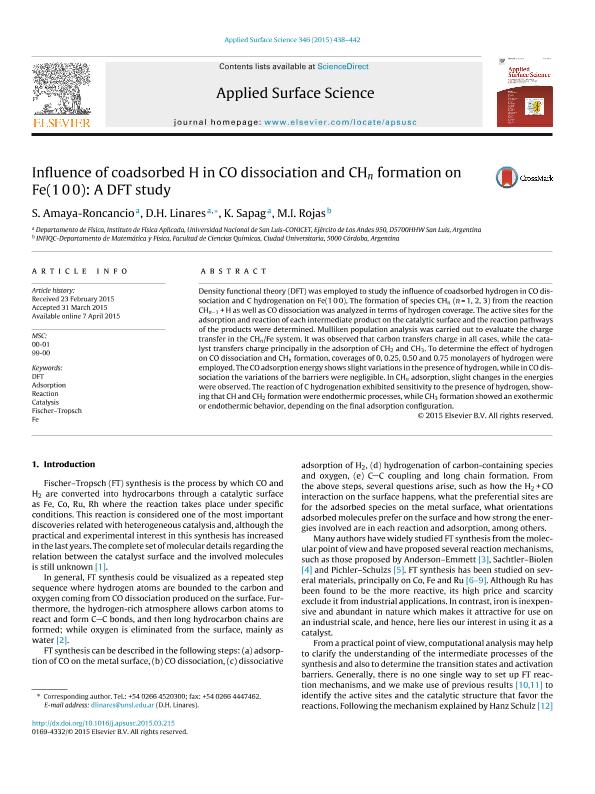Mostrar el registro sencillo del ítem
dc.contributor.author
Amaya Roncancio, Sebastian

dc.contributor.author
Linares, D. H.
dc.contributor.author
Sapag, Manuel Karim

dc.contributor.author
Rojas, Mariana Isabel

dc.date.available
2017-03-31T18:08:51Z
dc.date.issued
2015-05
dc.identifier.citation
Amaya Roncancio, Sebastian; Linares, D. H.; Sapag, Manuel Karim; Rojas, Mariana Isabel; Influence of coadsorbed H in CO dissociation and CH n formation on Fe (100): A DFT study; Elsevier; Applied Surface Science; 346; 5-2015; 438-442
dc.identifier.issn
0169-4332
dc.identifier.uri
http://hdl.handle.net/11336/14603
dc.description.abstract
Density Functional Theory (DFT) was employed to study the influence of coadsorbed hydrogen in CO dissociation and C hydrogenation on Fe(100). The formation of species CHn (n = 1, 2, 3) from the reaction CHn−1 + H as well as CO dissociation was analyzed in terms of hydrogen coverage. The active sites for the adsorption and reaction of each intermediate product on the catalytic surface and the reaction pathways of the products were determined. Mulliken population analysis was carried out to evaluate the charge transfer in the CHn/Fe system. It was observed that carbon transfers charge in all cases, while the catalyst transfers charge principally in the adsorption of CH2 and CH3. To determine the effect of hydrogen on CO dissociation and CHn formation, coverages of 0, 0.25, 0.50 and 0.75 monolayers of hydrogen were employed. The CO adsorption energy shows slight variations in the presence of hydrogen, while in CO dissociation the variations of the barriers were negligible. In CHn adsorption, slight changes in the energies were observed. The reaction of C hydrogenation exhibited sensitivity to the presence of hydrogen, showing that CH and CH2 formation were endothermic processes, while CH3 formation showed an exothermic or endothermic behavior, depending on the final adsorption configuration.
dc.format
application/pdf
dc.language.iso
eng
dc.publisher
Elsevier

dc.rights
info:eu-repo/semantics/openAccess
dc.rights.uri
https://creativecommons.org/licenses/by-nc-nd/2.5/ar/
dc.subject
Influence
dc.subject
Coadsorbed H in Co
dc.subject
Dissociation
dc.subject.classification
Ingeniería de los Materiales

dc.subject.classification
Ingeniería de los Materiales

dc.subject.classification
INGENIERÍAS Y TECNOLOGÍAS

dc.title
Influence of coadsorbed H in CO dissociation and CH n formation on Fe (100): A DFT study
dc.type
info:eu-repo/semantics/article
dc.type
info:ar-repo/semantics/artículo
dc.type
info:eu-repo/semantics/publishedVersion
dc.date.updated
2017-03-20T14:11:44Z
dc.journal.volume
346
dc.journal.pagination
438-442
dc.journal.pais
Países Bajos

dc.journal.ciudad
Amsterdam
dc.description.fil
Fil: Amaya Roncancio, Sebastian. Consejo Nacional de Investigaciones Científicas y Técnicas. Centro Científico Tecnológico San Luis. Instituto de Física Aplicada; Argentina
dc.description.fil
Fil: Linares, D. H.. Consejo Nacional de Investigaciones Científicas y Técnicas. Centro Científico Tecnológico San Luis. Instituto de Física Aplicada; Argentina
dc.description.fil
Fil: Sapag, Manuel Karim. Consejo Nacional de Investigaciones Científicas y Técnicas. Centro Científico Tecnológico San Luis. Instituto de Física Aplicada; Argentina
dc.description.fil
Fil: Rojas, Mariana Isabel. Universidad Nacional de Córdoba; Argentina. Consejo Nacional de Investigaciones Científicas y Técnicas. Centro Científico Tecnológico Córdoba. Instituto de Investigaciones en Físicoquímica de Córdoba; Argentina; Argentina
dc.journal.title
Applied Surface Science

dc.relation.alternativeid
info:eu-repo/semantics/altIdentifier/url/http://www.sciencedirect.com/science/article/pii/S0169433215008399
dc.relation.alternativeid
info:eu-repo/semantics/altIdentifier/doi/http://dx.doi.org/10.1016/j.apsusc.2015.03.215
Archivos asociados
